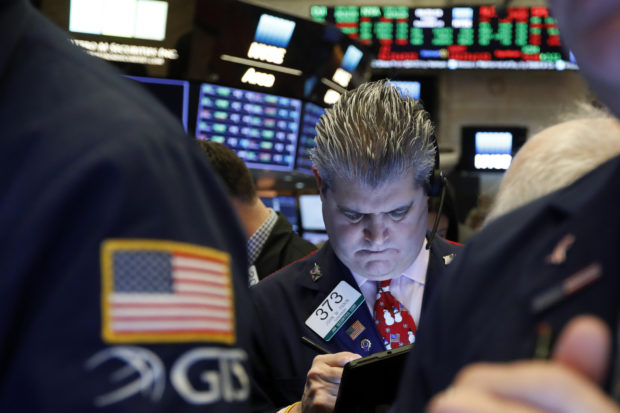S&P 500 index closes out 10th winning week in the past 11
Wall Street capped a mostly quiet week of trading Friday with broad gains for stocks and more record highs for the major indexes.

FILE – In this Dec. 13, 2019, file photo trader John Panin works on the floor of the New York Stock Exchange. The U.S. stock market opens at 9:30 a.m. EST on Friday, Dec. 20. (AP Photo/Richard Drew, File)
Technology and health care stocks powered much of the rally. The S&P 500 notched its 10th winning week in the last 11. The benchmark index also finished with a record high for the fourth time this week. The Dow Jones Industrial Average and Nasdaq composite also ended the week at new highs.
Momentum for stocks has been clearly upward for months, and the market is heading into what’s historically been a seasonally good period.
Rising optimism around a “Phase 1” trade deal announced a week ago between the United States and China has helped push stock indexes to records. Fears about a possible recession have also faded since the summer after the Federal Reserve cut interest rates three times, and the central bank appears set to keep them low for a long time.
“It’s just a benign continuation of the year-end rally based on no compelling reasons to scare people into selling,” said Tom Martin, senior portfolio manager with Globalt Investments. “You have not a lot of reasons to sell; maybe a few reasons to buy. So, it’s just a very slow, low volume drift upward.”
The S&P 500 rose 15.85 points, or 0.5%, to 3,221.22. With less than two weeks left in 2019, the S&P 500 is up 28.5% for the year.
Article continues after this advertisementThe Dow Jones Industrial Average climbed 78.13 points, or 0.3%, to 28,455.09. The Nasdaq composite added 37.74 points, or 0.4%, to 8,924.96. The Russell 2000 index of smaller company stocks picked up 4.81 points, or 0.3%., to 1,671.90.
Article continues after this advertisementRoughly two stocks rose for every one that fell on the New York Stock Exchange.
The 10-year Treasury yield edged to 1.92% from 1.91% late Thursday. The two-year yield climbed to 1.62% from 1.60%. The 30-year yield held steady at 2.34%.
The U.S. and China agreed last week to cut tariffs on some of each others’ goods and postpone other tariff threats. The interim trade deal has helped ease a key source of uncertainty for investors heading into next year.
Encouraging reports on home construction, industrial production and other economic data earlier this week helped keep the rally going.
More good news arrived Friday with a report showing U.S. households continue to spend amid a healthy job market. That is making up for hesitance by businesses to spend, and it’s helping to keep the economy growing at a moderate pace.
“What we’ve had in the last several weeks is a lessening of uncertainty,” Martin said.
Spending by U.S. households has been the main pillar for the economy recently, even as CEOs turned cautious amid all the uncertainty created by President Donald Trump’s trade wars.
Consumer spending rose 0.4% last month from October, the strongest growth in four months, according to the latest data from the Commerce Department. The increase in spending came as incomes rose 0.5% from a month earlier.
A separate report confirmed the economy grew at a moderate annual rate of 2.1% in the third quarter. Much of the growth from that July-through-September quarter came from stronger consumer spending.
Technology stocks accounted for a big slice of the market’s gains. Intel rose 1.7%. Health care and industrial stocks also notched solid gains. Cigna climbed 3% and Union Pacific added 1.7%.
Carnival jumped 7.6% for the biggest gain in the S&P 500 after it reported stronger earnings for the latest quarter than analysts expected. The cruise ship operator also gave a profit forecast for the upcoming quarter that topped analysts’ forecasts.
CarMax dropped 6.2%, the largest loss in the S&P 500, after it reported weaker earnings for the latest quarter than analysts expected.
Stocks have traditionally climbed in the last five days of each calendar year, plus the first two of the new year. It’s happened often enough that traders call it the “Santa rally,” and it’s brought an average gain of 1.3% for the S&P 500 since 1969, according to the Stock Trader’s Almanac.
Over the last 50 years, stocks have climbed in the seven-day stretch roughly three-quarters of the time.
Benchmark crude oil fell 74 cents to settle at $60.44 a barrel. Brent crude oil, the international standard, slid 40 cents to close at $66.14 a barrel.
Wholesale gasoline was unchanged at $1.71 per gallon. Heating oil declined 1 cent to $2.02 per gallon. Natural gas rose 6 cents to $2.33 per 1,000 cubic feet.
Gold fell $3.50 to $1,474.70 per ounce, silver rose 7 cents to $17.13 per ounce and copper fell 2 cents to $2.81 per pound.
The dollar rose to 109.47 Japanese yen from 109.28 yen on Thursday. The euro weakened to $1.1075 from $1.1123.
European stock markets closed broadly higher.